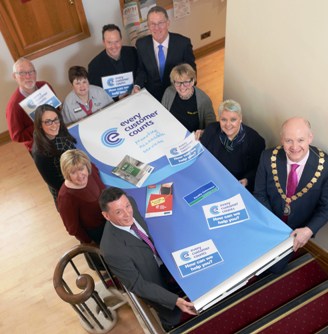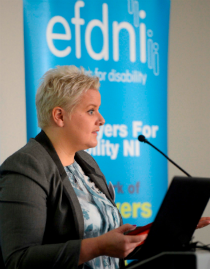"Every Customer Counts" Case Study - Specsavers, Newtownards
Leigh Nelson, a director of Specsavers, Newtownards, gives her account of steering her branch through the Every Customer Counts process and what it achieved for her business. The modifications to her business were predominantly to do with how they offer their service, making sure that all staff have the training, the ability and the willingness to engage with all sorts of customers. Physical adaptations were minimal.
Leigh says:

"I got involved with the Equality Commission’s Every Customer Counts initiative through my links with Newtownards Chamber of Trade. I was impressed with the aims of the initiative to include all sections of the community and at the sound business sense that the project made.
As retail director for Specsavers Newtownards it's my job to ensure that the store performs well and is compliant with every aspect of the law.
Specsavers, for those of you who have been on another planet, is a huge optical franchise and I am one of three directors who own and run the practice.
I am the main director on site, I have 20 staff, one of whom is my Lab Manager husband, and I have two sons. My elder son has autism, so I have some personal firsthand experience of special needs shopping and retailing.
Our store is based on the High Street in Newtownards. It is a long narrow building with all services on the ground floor. We have two test rooms, an onsite glazing lab and retail space for 1,200 frames.
We provide eye tests, spectacles and contact lenses and we have just introduced hearing services. We do repairs and hearing screening as well as provide optical emergency and triage facilities for patients. We perform around 250 tests per week and can have about 500 customers through our doors a week.
We are open seven days per week with early mornings and late nights. Our customer base is basically everyone and anyone able to get into the store, we see everyone from babies to the very elderly.
Being part of the Specsavers group means we have departments that keep us compliant in all areas of health and safety, disability access etc. Optical and retail processes are set up for the typical customer.
I initially thought we should be fine, everything is already done for us - website is compliant, photos and wording and so on, so what am I going to get out of this? Then I had a bit of a panic attack thinking: are we actually compliant?
First thing I did was to read the Every Customer Counts brochure and work out which type of business model we fell into as we were both retail and service providers so I read both sections. It gave really good examples of problem areas and gave various options on how to put them right.
Then I printed off the check list and made my way through it - I was surprised by how thorough it was, covering issues such as where patients can park nearby, and can they see your sign outside if they are colourblind or visually impaired.
I did have to go out and walk about the store and the surrounding street - being able bodied I actually wasn't sure where a disabled person could park nearby or exactly where the disabled parking bays are or where there is on street parking.
Completing the programme self check list was really easy and non-threatening - you know how you look at new proposals and think pound signs and automatically assume you’re going to be really bad? Well, this was surprisingly reassuring!
Physically, our store didn't need much done as it was a fairly recent build, all on one level. We had disabled access built in, so things like wheelchair access through doors and ramps from outside were fine. Inside, we had disabled access doors and toilets. All of our equipment is fairly mobile, so, as long as patients could sit up and forward, we could test them. Dispensing desks are low and chairs can be removed, so again all good. The one thing physically that it did highlight was our displays.
We needed to ensure that they were far enough apart if someone needed to turn around in a wheelchair and sometimes we would move them about for a change or to put up a promotional pod to re-merchandise and we’d forget that you need to leave a certain distance between for wheelchair users. So we stopped doing that and we put our promotional pod in the porch so it didn't block the doorway.
We looked at our main doors. They were just normal manual push pull opening - we normally would have an open door policy but in winter or wet weather (and let's face it that's a lot of the time!), it’s not possible to keep them open so our staff would open the doors for customers struggling with prams and wheelchairs when we saw them. An easy fix for this was a disabled access bell to attract attention very easily and cheaply - no need for automatic doors or disabled buttons. So now when staff are busy, customers can still get our attention if they are not able to open the doors themselves. A fix for less than £100! Not bad eh!!
We then looked at the services we provide. Areas like our scheduling procedures. We had a team meeting to gain feedback from the opticians and dispensing teams on the type of patients we were seeing and issues they had faced as a result. Usually our focus was only on volume – how many appointments we could squeeze into the clinics.
The outcome was surprising - we see a lot of kids, elderly, sight impaired, deaf and hearing impaired already, but we are now seeing a lot of special needs kids and teens, various health conditions including diabetics, younger babies and many customers whose first language is not English or who speak little English.

The outcome was twofold. Firstly, we introduced longer appointments for elderly or special needs patients. A normal eye test usually takes 20 minutes plus 10 minutes pre-testing - we added in quiet times such as late nights for kids and weekends when required.
Secondly, we found that some of the staff optometrists who were testing younger babies weren’t comfortable dealing with babies and perhaps had no children of their own, so we borrowed children from everyone willing to let us test their kids and did some additional training. We completed hospital dispensing courses.
We undertook deaf awareness training and learnt some basic signing and lip reading, and our loop system was charged.
We have a lot of elderly patients with dementia, so we sent our manager off to a local group training session to find out more and she related back the learning points. We also attended an Age Concern information session and again fed back the information on issues that these customers may be having.
Special needs covers a lot of areas. We had some experience with my son but decided we needed to do more so we invited his Primary 5 class in for a visit. We closed the store and set up stations with activities for them to do and for them to generally see what we do. We got a bit of PR on it but for the business, the benefits to the staff of dealing with special needs kids really helped.
We have many more patients coming in nowadays with little or no English. We have staff who speak second languages, so we would schedule them in and we also have a crib sheet or access to google for translation purposes, so again it was just ensuring that everyone knows the procedures and is comfortable using them.
Lastly, we looked at how we recruited staff. We normally looked for a confident go-getter ‘sell ice to Eskimos’ type. We changed this to include someone with empathy and able to deal with many types of customer.
Overall it was a great task to do. I recommend you read up on the sections of the Every Customer Counts brochure that apply best to your business and complete the checklist. It will give you a sense of what you have got right and what you need to look into, then plan your changes and draw up your action plan, prioritising the most important things you need to do first. Phone the guys at the Equality Commission and have a chat if you’re not sure - they really want to help.
For us, the outcome of the project has not been a massive increase in revenue from treating these patients, because in reality, in optics they are usually the ones who need the most help financially and physically.
Where we do see the benefits is in the recommendations and business that we get from those around these customers who support them and see what a positive impact the service we provided has had. There is also a great satisfaction that we as opticians can cater well and inclusively for all parts of our community.
The fact that customers trust us and return year after year is a great achievement for our store. There is no doubt that the Every Customer Counts programme has helped us to achieve that."
Photo caption (right): The 'Every Customer Counts' initiative being launched at Newtownards. Leigh Nelson pictured second right.